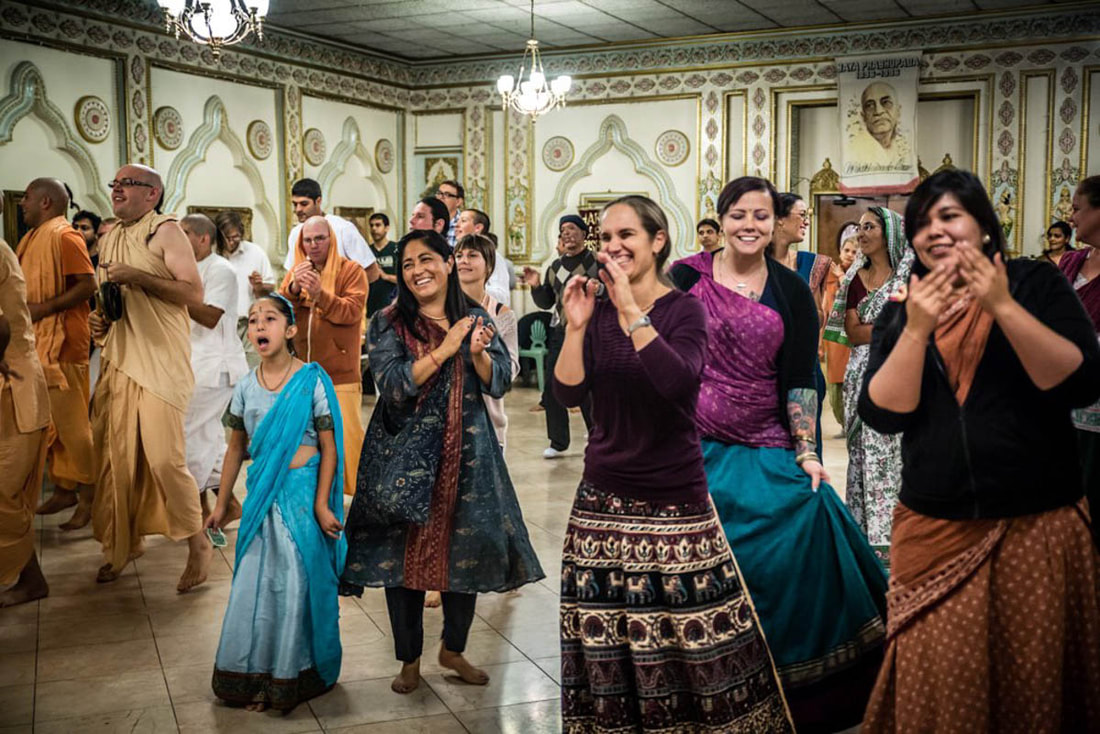Interestingly, our voice is very closely affected by our emotions – singing or speaking. When we are angry and agitated, or shocked and in fear, it will manifest through our voice. It will not easily be possible to hide our feelings. We may manage to somehow cover up our emotions to some degree, but whoever is perceptive will be able to feel the consciousness with which we say things. This can easily be understood once we accept the fact that every activity is executed through consciousness. It almost seems as if our voice reacts in an especially sensitive way to our consciousness. Our voice may even falter or be entirely choked up due to our emotions.
Consciousness travels on the sound vibration coming through our mouth, when singing as well as speaking. It may be Krishna’s divine arrangement, so that the sound vibration of the holy name chanted in pure devotion can spread far and wide and uplifts everyone who hears it!
Within Christianity we also come across this understanding. A Christian priest will recite a famous prayer in Latin before he performs his sermon: "dominus sit in corde meo et in labiis meis", which means, ‘May the Lord be in my heart and on my lips’. The understanding is that whatever is in my heart comes out through my lips.
This fact brings us to the topic of kirtan – a highly transcendental affair. Kirtan is not merely nice music, but a mysterious happening: The consciousness of the kirtan leader travels on the sound vibration coming from his mouth, and affects the hearts of those in the audience. If we are eager to catch some drops of whatever an elevated kirtaneer carries within his heart – his devotion, purity, selfless service attitude and many other sublime qualities, then our heart will be receptive. This eagerness, combined with attraction and liking of the person, will open our heart to receive some droplets of the qualities the person carries within his heart, transferred through the sound vibration coming from his mouth.
We can picture the analogy of dyeing a piece of cloth. If the cloth is white, then we have a good chance that the colour will come out nicely and will stick. But if the cloth is not bright and white, we will get a brownish shade that may not stay, but will wash out soon afterwards.
In the same way, if our heart has a certain level of purity and is open through our eagerness and longing, then we get a nice colouring of our heart, which will stick at least for some time. But if our heart is contaminated by material desires and attachments, and we are not experiencing a deep eagerness to associate with the sadhu, but harbour a negative attitude towards him, then our heart will not be open and receptive, and the colouring process will not fully take place.
In this way we can understand the subtleties taking place in sadhu-sanga: The subtle energy of consciousness travels from one heart to another – as if by contagion. This exchange is highly magnified through sound vibration. Therefore, Srila Bhaktivinoda Thakura recommends in his Bhaktivinoda-vani-vaibhava:
"suddha-bhakta anugati kirtana haile sekhana jaya"
"If kirtan is performed under the auspicious guidance of a pure devotee,
then one should attend".
Not only the consciousness of the person leading the congregational chanting of the holy name, but also of the devotees playing the instruments affects the atmosphere and spiritual power of the event. As we established, every activity is executed through consciousness. Thus, even playing the instruments takes place through consciousness, and the quality of the consciousness with which the mridanga or kartalas are played travels on the sound coming from the instruments.
We may have the practical experience, when a kartala or mridanga player wants to show off and be noticed in a kirtan, he will play those instruments always a touch too loud because he wants to be noticed. And for a perceptive person this will disturb if not pollute the entire kirtan experience. The same refers to clapping our hands; it is also considered a musical instrument and has to be done in a humble mood of wanting to serve the maha-mantra. If we clap our hands with the desire of wanting to show off and be noticed, such consciousness will pervade the atmosphere and pollute the kirtan.
We also participate in a kirtan by dancing. This may also be a convenient forum for making a show and drawing attention to ourselves, rather than Krishna and His holy name being the centre of attention. Men have their ways of trying to be in the centre while dancing – jumping around in an uncontrolled manner while displaying their ecstasies. And women have their ways of bringing attention to themselves, too. Extravagant dancing distracts other’s minds and can even invoke lusty desires in some devotees’ hearts, especially if the dancing is sensually provocative. Since the female energy is very powerful, a woman can easily bewilder the minds of others around her through her sensual dancing, showing off her body while dressed in a revealing fashion. However, kirtan is not meant to be a show or performance, nor is the dancing.
In this way we can easily understand that kirtan performed with the intention to show off, trying to bring attention and glory to ourselves rather than the Lord will not have much spiritual potency. It may rather invite a contaminating effect. Then such consciousness of showing off – desiring name, fame and adoration will travel on the sound vibration of the kirtan and will pollute everyone’s heart with those material desires. We can imagine such chanting to be like a poisonous medicine capsule – from outside it may look like the real thing, but since it has poison inside, it pollutes our hearts. Unless we are spiritually powerful enough to counteract and neutralise such contaminations with our own advanced level of Krishna consciousness, we may get affected.
On the 14th of June I traveled on to Los Angeles...
Your servant, Devaki dd








 RSS Feed
RSS Feed
